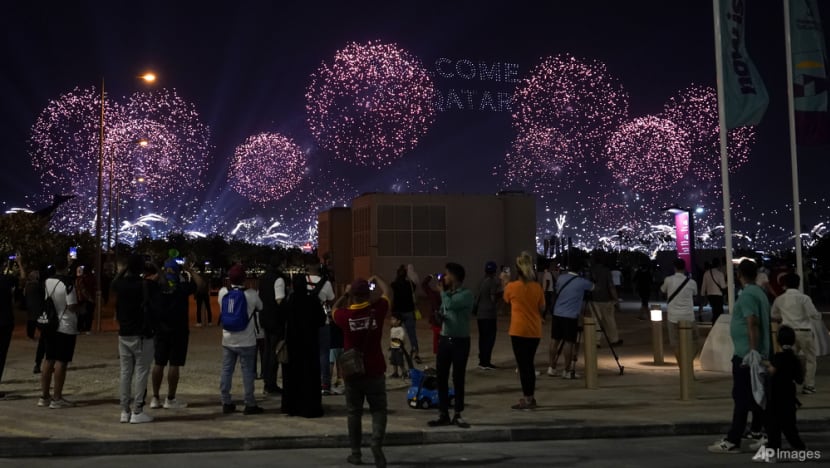Commentary: The Gulf is partying while it can
But the joy of hosting the World Cup in an oil and property boom will not last unless productivity improves, says Ruchir Sharma for the Financial Times.

Fans watch fireworks after the World Cup inauguration match between Qatar and Ecuador at the Corniche sea promenade in Doha, Qatar, Nov 20, 2022. (AP Photo/Moises Castillo)
NEW YORK: If you want to escape the global gloom, just take a flight from its epicentre, London, to any leading capital of the Gulf, the only region in the world where economic growth forecasts are rising.
As host of the FIFA World Cup, Doha has been bubbling over with anticipation, as have its neighbours, who are welcoming the overflow from Qatari hotels. Dubai is enjoying yet another real estate boom. Regional rivals like Riyadh are racing to be the next Dubai, funnelling oil profits into property mega-projects.
Many Gulf leaders recognise that a boom built on high oil and property prices is unlikely to endure, but that age-old problem can wait. Despite concerns in the west about human rights across the region, the party is happening now.
With 28 buildings over 300m high, most built in the past 10 years, Dubai is easily the most vertical city in the world, making even Manhattan and Shenzhen in China look flat by comparison.
Now in its third and most effervescent real estate boom of the past decade, Dubai is setting records for the number and value of buildings sold, with sale prices rising fastest at the upper end of the market. Dinner conversations at Dubai’s many globally branded restaurants, from Armani to Zuma, revolve around which billionaire paid how much for the latest luxury villa.
Saudi Arabia and the United Arab Emirates, which includes Dubai and Abu Dhabi, account for nearly 75 per cent of the Gulf economy and are home to its financial centres.
Proceeds from initial public offerings are down to a trickle in much of the world so far this year – collapsing by 95 per cent in New York to just over US$7 billion – but they have increased more than threefold in Riyadh, fivefold in Abu Dhabi and have soared from zero to US$7 billion in Dubai.
SWEEPING REFORMS
The Gulf boom started slowly, on the back of crisis-driven reforms over the past decade, then took off when oil prices started to climb in early 2020. Following the global oil price collapse of 2014, which triggered a bust in Dubai property, the emirate made it even easier to move there tax-free.
Now the city attracts an ever-wider array of foreign buyers, from big hedge funds to Russian tycoons seeking a haven from sanctions related to the war in Ukraine.
The Saudis responded to the 2014 oil price shock with even more sweeping reforms, streamlining the state, easing religious restrictions, making it easier for women to work and foreigners to invest. Public sector wage cuts have helped Saudi Arabia to cover its budget with oil prices under US$70 a barrel, down from just under US$100 in 2015.
The share of Saudi women who hold jobs has doubled in just five years to 35 per cent. Longtime visitors to the country are now astounded to be greeted by female border agents, and to find raves, coffee shop dating and Halloween parties in a country that banned any public mixing of the sexes only a decade ago.
The old ways have not entirely disappeared, however. Religious police no longer enforce the hijab but most women still wear it. Foreign visitors are asked not to show their knees.
Related:
MOVING PAST THE BOOM BUST CYCLE OF OIL AND REAL ESTATE
Still, the Saudis are moving towards openness at a time when many countries are turning inward. Riyadh seems serious about challenging Dubai as the commercial crossroads – if not quite the freewheeling Las Vegas – of the Gulf.
To outdo Dubai’s Burj Khalifa, the world’s tallest building by far, the Saudis began work last month on The Line, a 105-mile-long “linear city” comprising two parallel skyscrapers that would be the world’s longest and largest buildings by far, if the project actually gets finished.
The idea is straight out of Dubai: Build it spectacularly big and they – global celebrities, financiers – will come. Gulf officials also talk endlessly now about drawing tech entrepreneurs to the party as well.
Technology is an important driver of productivity growth. No region has a worse record in this regard than the Gulf. On average, core productivity has shrunk more than 2 per cent a year in the six Gulf economies since data begins in 1980, according to Citi Research, which ties this failure to ineffective governments that have struggled, in particular, to regulate soundly and provide ready access to credit.
Negative productivity growth helps explain why, in an oil state like Saudi Arabia, per capita income rises towards developed world levels only when oil prices are rising, then retreats when they are falling.
Gulf leaders recognise the task that confronts them: Directing more investment into technology and manufacturing in order to free their economies from the boom bust cycles of oil and real estate. Without such changes, their fate will be periodic parties, not lasting progress.














